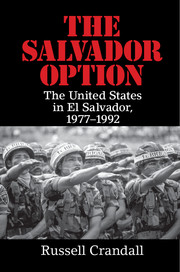Book contents
- Frontmatter
- Dedication
- Epigraph
- Contents
- List of Figures
- List of Organizations
- Acknowledgments
- 1 Introduction
- PART ONE EL SALVADOR IN THE COLD WAR
- 2 Farabundo Martí, La Matanza, and a Stolen Election
- 3 The United States in Latin America
- 4 American Military Mission in El Salvador
- 5 A Divided Nation: Military Traditions, Democratic Third Way, and Liberation Theology
- 6 Guerrillas Are Born
- PART TWO JIMMY CARTER
- PART THREE RONALD REAGAN
- PART FOUR GEORGE H. W. BUSH
- PART FIVE POSTWAR
- Notes
- Bibliography
- Index
6 - Guerrillas Are Born
from PART ONE - EL SALVADOR IN THE COLD WAR
Published online by Cambridge University Press: 05 June 2016
- Frontmatter
- Dedication
- Epigraph
- Contents
- List of Figures
- List of Organizations
- Acknowledgments
- 1 Introduction
- PART ONE EL SALVADOR IN THE COLD WAR
- 2 Farabundo Martí, La Matanza, and a Stolen Election
- 3 The United States in Latin America
- 4 American Military Mission in El Salvador
- 5 A Divided Nation: Military Traditions, Democratic Third Way, and Liberation Theology
- 6 Guerrillas Are Born
- PART TWO JIMMY CARTER
- PART THREE RONALD REAGAN
- PART FOUR GEORGE H. W. BUSH
- PART FIVE POSTWAR
- Notes
- Bibliography
- Index
Summary
The aristocratic dominance was in fact a marriage between the military and the aristocracy so that the military arranged to provide the President and the aristocracy the direction and money. So you had an insurgency and a reform movement coming out of a tremendous thirst for change.
– American ambassador to El SalvadorWe know very little about who exactly is out there in the hills.…We know that they receive arms through Nicaragua. But beyond that I don't know very much.
– U.S. Diplomat official, San Salvador, 1982The insurgency was a many-headed thing – as most of these things [Marxist insurgencies] were. You had the hard core real communists and you had the other guys who were land reformers and maybe naïve to go along with the really tough guys but who wanted change and who felt that the only way to change that system was to do it through violence.
– Roger Fontaine, Reagan administration official“The Revolution Had Begun”
At the time of the fraudulent presidential election in 1972 that denied the presidency to José Napoleón Duarte, the only guerrilla organization was the Popular Forces of Liberation (Fuerzas Populares de Liberación “Farabundo Martí,” FPL), which limited their operations to kidnappings. Thus, while there were formidable Cuba-style focos next door in Guatemala and Nicaragua, for most of the 1970s El Salvador was devoid of these insurgent forces – at least in their more formal role as armed guerrilla groups. A dozen young communists, including former seminarian Salvador Cayetano Carpio, founded the FPL in 1970 as a breakaway revolutionary faction of the Communist Party. Carpio went on to become the group's top commander.
The doctrinaire Carpio (or Commander Marcial, his assumed name) enjoyed being referred to as the Ho Chi Minh of Central America. While other radicals were focused on an insurrection-style effort similar to the successful Cuban revolution in 1959, Carpio opted for a Ho-style “prolonged struggle” in order to win a war of attrition against the despised military. By 1980, the FPL had swelled to around 2,000 troops operating in the single mountain province of Chalatenango, a locale where they remained for the war's duration. For Carpio, El Salvador's revolution would have to be Marxist-Leninist and represent the “triumph of the worker-campesino alliance.
- Type
- Chapter
- Information
- The Salvador OptionThe United States in El Salvador, 1977–1992, pp. 65 - 76Publisher: Cambridge University PressPrint publication year: 2016

